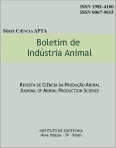Intensidades de seleção e resposta direta e correlacionadas em 10 anos de progênies de bovinos das raças nelore e guzerá selecionadas para peso pós-desmame
Palavras-chave:
seleção, peso pós-desmame, Nelore, Guzerá, mudança genética, resposta à seleçãoResumo
Avaliou-se a seleção praticada em pesos pós-desmame e a mudança genética em características de seleção direta e correlacionada em 10 anos de progênies de bovinos nelore e guzerá. A partir de 1980 foram formados dois rebanhos de seleção, um nelore (NeS) e outro guzerá (GuS), cada um com 120 vacas e 6 touros e um terceiro, o controle, também nelore (NeC) com 60 vacas e 4 touros dos plantéis da Estação Experimental de Zootecnia de Sertãozinho. Anualmente nos rebanhos NeS e GuS, eram selecionados 3 machos, com base em altos diferenciais em P378 (peso 378 dias) obtido ao final de provas de ganho em peso, e 20 fêmeas de altos diferenciais em P550 (peso 550 dias), a pasto. No rebanho NeC a seleção anual era de 2 machos e 10 fêmeas com diferenciais em torno de zero (média do rebanho). Os diferenciais de seleção efetivos no pai médio das progênies nascidas de 1981 a 1990 foram, em média, de 31,5; 25,7 e 4,2kg para NeS, GuS e NeC, respectivamente. As intensidades de seleção correspondentes foram 1,18; 0,92 e 0,17 u.d.p.. O intervalo e o coeficiente de geração atingiram valores de 5,0 anos e 2,3 gerações (progênie de 1990) respectivamente nos três rebanhos. A mudança genética total (média) em P378 foi de 22,5 e 17,2kg para NeS e GuS, respectivamente. Valores correspondentes para P550 de fêmeas foram 9,4 e 4,6kg. A mudança genética anual de P378 foi estimada em 2,4 e 2,2kg/ano para NeS e GuS, respectivamente. Houve significativa resposta correlacionada no peso ao nascer, ao desmame e no ganho em peso diário em prova de ganho em peso, tanto em NeS como em GuS.Downloads
Downloads
Publicado
Edição
Seção
Licença
Os autores não serão remunerados pela publicação de trabalhos, pois devem abrir mão de seus direitos autorais em favor deste periódico. Por outro lado, os autores ficam autorizados a publicar seus artigos, simultaneamente, em repositórios da instituição de sua origem, desde que citada a fonte da publicação original seja Boletim de Indústria Animal. A revista se reserva o direito de efetuar, nos originais, alterações de ordem normativa, ortográfica e gramatical, com vistas a manter o padrão culto da língua e a credibilidade do veículo. Respeitará, no entanto, o estilo de escrever dos autores. Alterações, correções ou sugestões de ordem conceitual serão encaminhadas aos autores, quando necessário. Nesses casos, os artigos, depois de adequados, deverão ser submetidos a nova apreciação. As opiniões emitidas pelos autores dos artigos são de sua exclusiva responsabilidade. Todo o conteúdo deste periódico, exceto onde está identificado, está licenciado sob a Licença Creative Commons Attribution (CC-BY-NC). A condição BY implica que os licenciados podem copiar, distribuir, exibir e executar a obra e fazer trabalhos derivados com base em que só se dão o autor ou licenciante os créditos na forma especificada por estes. A cláusula NC significa que os licenciados podem copiar, distribuir, exibir e executar a obra e fazer trabalhos derivados com base apenas para fins não comerciais.













